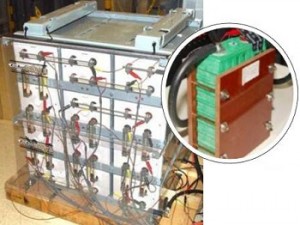Sandia provides trusted, independent, third-party testing and validation of electrical energy storage systems and advanced storage technologies, from cell to MW systems in both grid and simulated environments.
Electricity Generation, Transmission and Energy Storage Systems
Utilities and other electricity and transmission providers and regulators often require that equipment be proven safe and reliable before it is permitted on the grid. However, energy storage manufacturers and integrators are often unable to afford or provide the logistics necessary for this long-term testing and monitoring. The Energy Storage Test Pad (ESTP) in conjunction with the Energy Storage Analysis Laboratory (ESAL) provides trusted, independent, third party testing and validation from the cell level up to 1+ MW AC electrical energy storage (EES) systems. In addition to long-term testing, Sandia provides pre-certification, pre-installation, and verification of EES systems. Our goal is to develop advanced energy storage technologies that will increase reliability, performance, and competitiveness of electricity generation and transmission.
Testing and Validation

Sandia’s ESTP and ESAL can provide users the venue for testing and validation in either a direct grid connection or using a simulated charge-discharge protocol that, accompanied by detailed diagnostics and analysis, can provide verification of a storage device’s reliability.
With the capabilities of the ESTP, ESAL and their staff, users can analyze system performance relative to standards and applications, develop new testing procedures, and support development of new energy storage standards. Sandia’s battery testing facilities are supported by extensive resources across Sandia for battery development, characterization, materials analysis, and abuse testing, providing a full array of expertise and capabilities to aid with battery testing and evaluation as well as R&D activities.
The ESTP and ESAL can test energy storage devices to manufacturers’ specifications through characterization and application specific cycle testing. These include both power and energy applications such as: energy time shift, capacity, load following, area regulation, voltage support, T&D deferral, demand charge management, and power quality. They can also help users evaluate system parameters including storage device efficiency, performance to specifications, reliability, and balance of plant operation.
Working with the ESTP and ESAL
The ESTP and ESAL are available to serve a wide variety of customers including EES system manufacturers; utilities, independent system operators, independent power producers, and regional transmission operators; commercial, industrial, government agencies, and renewable project developers; and independent and government R&D labs and universities.
Partnering institutions and customers of the ESTP and ESAL have several options for protecting IP and for funding their testing activities. These available options fully support the needs of battery developers and manufacturers at any stage of battery development. Customers may use a Work for Others agreement with Sandia to provide private reporting on battery performance; ideal for early stage batteries and development. Alternately, through a collaborative development process that may involve a cost share between Sandia and their partner, a test programs results will be publicly released through a final report.
Contact ESTP’s David Rosewater, (505) 844-3722, or ESAL’s Summer Ferreira, (505) 844-4864, for more information.
